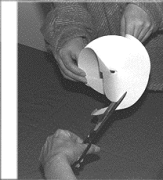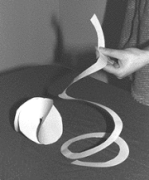What if each radius were to grow after we had made our sphere? Say the circles grew from a three inch radius to a one foot radius. Would the surface still be covered? No, because the integrity of the surface would be breached. There would be empty spots in it. We would need to add more circles to fill it in. That is because we have used real paper which has a real thickness. But we are illustrating a process that doesn't. My saddlemniscus is a two dimensional object. The circles that comprise it have no thickness. That is what keeps the surface consistant regardless of the radius we are looking at. The saddlem has no natural radius. Each saddlem is infinite in both degree and radius.
Take the example of matter-energy conversion. For years teachers have told students that what we observe as matter or what we observe as energy are just interchangeable manifestations of something. How can it be doubted? After all, atomic energy is a reality of life from the atomic bomb to nuclear power plants. But how could it take place? What is the mechanism which would allow what we see as matter to become something else altogether?
Well this is a way that such a transformation could occur. In UU Basics we created a 1080° saddlem. We then ask you to pick a random spot on the edge and begin to tear along the edge a strip about 1" in width. The strip falls away as a helix (unbound) or a twisted ring (bound) depending upon how you do it.


Thus we show how an object with one nature can exhibit a completely different one. Then we ask you to extend your imagination and visualize an infinite saddlem with this edge unwinding all at once. It would come off as a shell. We show you how to do this in the article "Photon In A Fishbowl". We also discuss and illustrate it in "Dimension Part 4". As the edge is no longer bound to a parent center, it would be free to expand in all directions. It would become more tenuous as it expands. What would happen if a part of it were to be torn away as in our paper exercises? Would it then tend to revert to its helical nature (bound or unbound)? Could it locally take helical form and still retain its overall integrity as an expanding shell? Think of a star emitting light. Think of an electron emitting a photon. Think of that photon striking your eye and the eye of the person next to you.
There is another way we can subtract from our saddlem. What if the unwinding didn't stop as a shell but kept unraveling from the parent sphere in a spiral? The spiral would unravel the surface of the infinite saddlem inward to the center. The saddlem would disappear. But there is no particular direction to the process. Because we are tearing paper it seems to imply dissolution. The opposite is just as likely, a tenuous ribbon contracting to a sphere. Try to visualize it expanding and contracting, becomming more or less solid or tenuous. This could then be a model of a system demonstrating wave particle duality.
It is possible to reverse the direction of the initial helix as you add circles of paper together. In workshops, this is the mistake that most commonly frustrates would be saddlem makers. Once the stack of circles has been assembled into the bound helix stage, the edge should form a helix going dextro (right) or levo (left). However, you can make a saddlem with a combination of connected right and left helixes. Each could be twisted into its own saddlem while remaining connected to the whole. Say that dextro is + and levo is -, as in charge.
Imagine a super saddlem consisting of a bunch of infinite saddlems from connected but reversing helixes. If I have an even number, the number of pluses will equal the number of minuses and the whole thing will appear charge neutral. If I have an odd number, it will carry the charge of the "last one". It will, at any rate, have a lot more saddleness than a single infinite saddlem. Which is like saying any number times infinity is infinity only more of it. Nonetheless, this is very reminiscent of mass/charge disparities between protons, electrons and neutrons.
I believe that energy is a two dimensional phenomenon that we view from a three dimensional platform. I may be alone in that belief and all my writings may be nonsense. Maybe the saddlem relates to the way such things really occur or maybe it doesn't. But this is an excercise that students can perform which will help them to visualize a non-intuitive process.